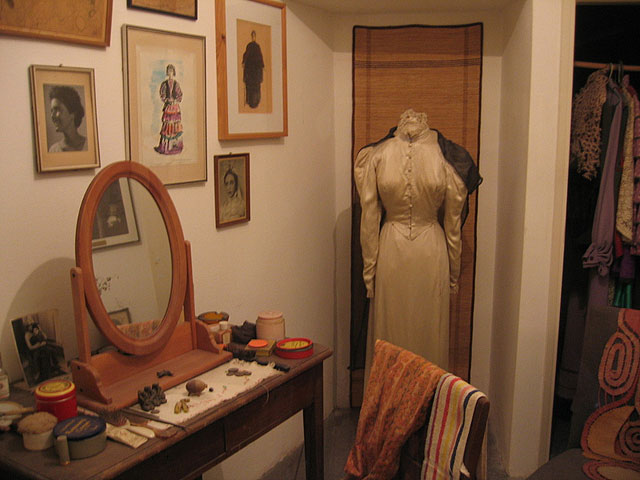By Rivka Borochov
It took nearly five years and $26 million to complete, but the renovations to
Israel’s National Theater in Tel Aviv, Habima, were worth the wait.
Habima, which means “The Stage” in English, is a long-established theater with roots a century old. Its troupe of 80 actors and 120 support staff traces its history back to early 19th century Lithuania and Moscow, but today the theater is firmly planted in Israeli culture.
Habima was the first art venue of its kind to demonstrate to new immigrants that their “new” Hebrew language could be used in art, and not just as an old language of the Bible. The theater is a cornerstone in the establishment of the Jewish state and in the revival of Hebrew as a spoken language.
Performed at first in Yiddish, and then Hebrew, Habima’s shows have always reflected Israeli culture, whether it’s a play adapted from the novelist Ron Leshem’s screenplay Beaufort, or a play based on the popular novels of Amos Oz. Works by other modern legends -- such as the late Hanoch Levin, often regarded as the best modern Hebrew playwright -- are must-sees for tourists and newcomers looking to access the complicated yet passionate Israeli culture.
The plays produced and performed at Habima are often subtitled so a wide variety of audiences can access them.

Habima Theater’s sparkling new facility in Culture Square
Connecting a square of culture
The new renovations made to the Habima Theater now connect it to two other centers of culture in Tel Aviv, the Mann Auditorium and the Helena Rubinstein Pavilion of Art, which together make up Tel Aviv’s Culture Square. The idea is similar to the Lincoln Square complex in New York City.
“It’s an international theater, and the national theater of Israel,” Habima spokeswoman Osnat Chen says proudly. “And it’s the first one for Israel, with four modern theaters and many places for the audience.”
Chen notes, “This is the same theater where Hana Rovina performed,” referring to the famous actress who performed in the iconic Jewish play The Dybbyk, which had a run life of no less than 40 years. She played a young bride possessed by a demon.

Yiddish actress Hana Rovina’s old dressing room at the Habima Theater
Photo courtesy of Wiki Commons
Thanks to architectural enhancements overseen by Ram Karmi on the original building designed by architect Richard Kaufmann, the theater’s renovations have beautified the center of Tel Aviv. The project includes a new courtyard, designed by the popular international monument-maker Dani Karavan.
“We are just moved back in after the renovations and the theater is up and running. We waited five years, and it was like being in exile,” Chen says. Right away, the troupe began preparing for a 10-day international festival in March to mark the Tel Aviv-Jaffa municipality’s Art Year 2012 initiative.
Adi Yekutieli, director of Art Year, says the event celebrates the renewal of several Tel Aviv cultural centers, including Habima and the recently opened Tel Aviv Museum of Art building showcasing Israeli art. The new wing was named
Best Museum in the prestigious Travel and Leisure magazine awards for 2012.
Noting that experiencing Israeli art is the best way to transcend politics, Yekutieli is expecting many tourists to travel to Israel this year to see theater, music, dance and plastic arts.
Providing a dramatic look at Israel today
Habima Theater is keen to examine artistically the diversities of the city. Jaffa, for instance, is a biblical city that today is home to a population of about 40% Muslim, 40% Jewish and 10% Christian.
The theater’s homegrown productions explore, for example, Jewish-Arab dialogue; the religious-secular divide in Israel; the Holocaust; issues faced by new immigrants; and the influx of foreign workers who migrate to and sometimes settle in Israel, not always legally.
Maybe this wasn’t the original vision of linguistic pioneer Eliezer Ben-Yehuda when he revived Hebrew at the turn of the 19th century. Ben-Yehuda is almost single-handedly responsible for taking a language used for religious purposes only and turning it into a modern tongue spoken by nearly eight million Israelis today. But it was the Habima Theater, and the cultural center it provided for this new language, that helped spread Ben-Yehuda’s dream.
Some of the earliest plays performed at Habima in Israel include Der Oytser (The Treasure), written in Yiddish by Sholom Aleichem; The Crown by David Calderon, a play that premiered in Tel Aviv in 1929; and the famous Dybbuk.
The original Habima Theater was completed in 1946, and it’s the same home the troupe occupies today, including in-house rehearsal studios and offices. The new renovations have added about 500 square meters, giving a new kind of energy to Hebrew theater, which also performs works of Shakespeare and Moliere.
The “new” Habima was dedicated last November with Hanoch Levin’s Morris Schimmel, and a gala celebration took place in January. It now has cutting-edge sound and lighting equipment; improved electrical, sewage and water systems; a five-level underground parking lot; a modern cafeteria; more emergency exits and state-of-the-art sprinkler systems; and accessibility for people with disabilities.
The municipality contributed $15 million toward the renewal project.